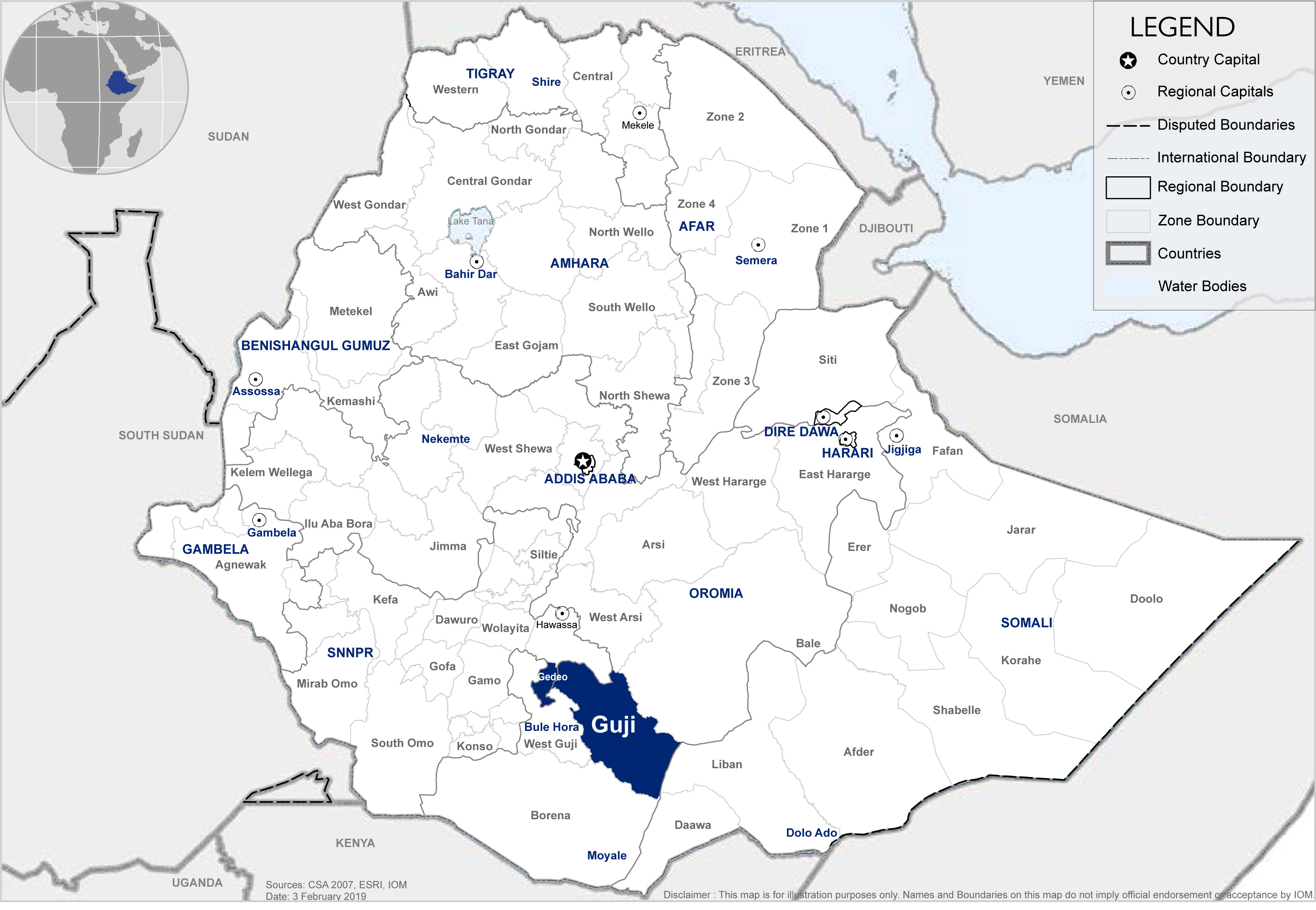Addis Ababa – “I am not giving up. This is where our new home will stand.”
Carrying a heavy stack of wood on his shoulders, Tadese stands at the site where he plans to rebuild a new house for his family. All that is left for him is to salvage from the ground are the remaining charred pieces of wood from their old, burnt down home. Tadese lost his home in 2018 when a conflict broke out in the Southern part of Ethiopia.
A father of 11, and husband to three wives, Tadese is anxious but hopeful that he can rebuild to accommodate his large family.

Tadese stands next to what used to be the foundation of his burned down house in Gedeo Zone, Ethiopia. Photo: IOM/Alemayehu Seifeselassie
“We did not have much to rebuild our house, but these wooden pieces are coming in handy. My neighbours and I are helping each other start new lives and have new homes for our families,” he adds.
Despite these challenges, Tadese is looking positively ahead. He is among the many returnees who are seeing new beginnings in what was once a conflict area.
In Gedeo and Guji in the Southern part of Ethiopia, a mix of conflicts and disasters over the past two years has caused the mass displacement of more than 1.7 million people. Intercommunal violence in Gedeo zone alone caused the displacement of more than 950,000 people from January to December 2018.

Violence has left many families homeless.

Tadese stands with one of his wives and some of his children in front of their temporary house. Photo: IOM/Alemayehu Seifeselassie
Two years later, with community leaders determined to maintain peace, the conflict is fading away and displaced communities are returning home.
Children are going back to school and parents are rebuilding their houses again – a challenging feat, especially during the cold season. Families are arriving back to their areas of origin in Gedeo and Guji practically empty-handed.
Returnees like Tadese are constructing their new homes collaboratively, employing local building techniques using readily available materials.
The shelter typology comprises of industrial materials such as corrugated iron sheets, nails, locking mechanisms, hinges as well as eucalyptus poles that form the skeletal structure. Many of the displaced returnees try to devise wood pieces, saving whatever they can, and aiming to lower the cost of reconstruction.
The International Organization for Migration (IOM) helps returnee families buy the materials needed for families like Tadese’s to get what they need. Each family is given a full reconstruction kit that costs USD 650 on average. The kit comprises both industrial materials as well as locally available materials, such as Eucalyptus tree poles. The items are distributed by IOM with the help of the government, district and town administrations.
IOM also teaches the communities how to build new homes and hires local carpenters to help some families who need extra assistance with construction.

Household materials distribution for returned families (formerly displaced families) at Kercha, Ethiopia. Photo: IOM/Alemayehu Seifeselassie
IOM is also working with the government to empower community leaders to conduct peacebuilding initiatives. Groups of five to ten people in the community are formed to support everyone, making the way for stronger social cohesion and integration with the host community. The safety and dignity of families are ensured throughout the building process.
Housing, Land and Property (HLP) rights are taken into consideration to ensure the principle of “do no harm” is upheld and the right to ownership for IDPs is reinstated where lost. HLP rights are an essential steppingstone for displaced people to rebuild their lives. A complaint and feedback desk is also set up to review cases that may not have been addressed during the selection and implementation process. Where necessary, these are referred to the local administration.
A typical colourful house at Gedeo Zone, Ethiopia. Photo: IOM/Alemayehu Seifeselassie
A young man taking a break from digging cylindrical septic tank at Gedeo Zone, Ethiopia. Photo: IOM/Alemayehu Seifeselassie
A young man digging cylindrical septic tank at Gedeo Zone, Ethiopia. Photo: IOM/Alemayehu Seifeselassie
splitting wood for a house construction at Gedeo Zone, Ethiopia. Photo: IOM/Alemayehu Seifeselassie
False banana leaves and barks are commonly used to make roofs at Gedeo Zone house construction, Ethiopia. Photo: IOM/Alemayehu Seifeselassie
While the main burned down houses are under construction, the community often builds such temporary houses to reside in at Gedeo Zone house construction, Ethiopia. Photo: IOM/Alemayehu Seifeselassie
IOM is providing the shelter construction assistance through the financial support from the Federal Government of Germany, USAID, UN Central Emergency Response Fund (CERF), and the Ethiopia Humanitarian Fund. The Shelter construction is among the variety of rehabilitation efforts the organization carries out at Gedeo and West Guji zones in Ethiopia.